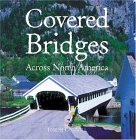Covered Bridges Across North America, by Joseph D. Conwill
Like many roadtrippers, I have come across covered bridges in a number of states, but I never had much appreciation for the variety of styles and construction techniques until I read Joseph D. Conwill's latest book, Covered Bridges Across North America. Now, it is extremely unlikely that I will ever drive by a covered bridge without first stopping and checking to see what kind of trusses were used to construct the bridge. Conwill claims to have seen every single covered bridge that still exists in North America since 1966. After reading this book and knowing that he is the editor of "Covered Bridge Topics," the quarterly magazine of the National Society for the Preservation of Covered Bridges, I have little doubt his assertion is true.
The majority of the photos in the book were taken by the author, and you may find yourself as amazed as I was by his evocative photographs and the wide variety of covered bridges that are still in existence (or were until recently) in places as far flung as Alaska, Oregon, California, Kentucky, Ontario, New Brunswick, and the New England states.
For those readers with less than a driving passion for engineering or historical details about the construction of the bridges, the extensive information about the various bridge patents issued to builders during the heyday of the covered bridge construction period could get somewhat tedious, but Conwill's light-hearted prose effectively lays the framework for a growing appreciation for these bridges and the creative folks who built them. As a result of reading this book, it is even possible that I would be able to tell the difference between a Kingshead, a Palmer, a Double Lattice, and a Howe truss. I could even do a decent job of explaining how the spans were constructed. The author lays out a convincing argument for what constitutes a "real" covered bridge as opposed to a "replica bridge." His discussion of the "replica bridges" built during the last forty years or so is quite interesting and amusing.
Unfortunately, covered wooden bridges are
vulnerable to arson, vandalism, and the challenges imposed
by age, severe weather, and population growth. While it is
a sad fact that many of the bridges profiled in this book
no longer exist, Conwill's work provides an excellent guide
for getting out there and seeing some of the estimated 1000
wooden covered bridges that are still out there to enjoy.
And if journeying to some of the more remote locations is
problematic, the author's beautiful photos make for excellent
armchair traveling.
Mark
7/04/04

